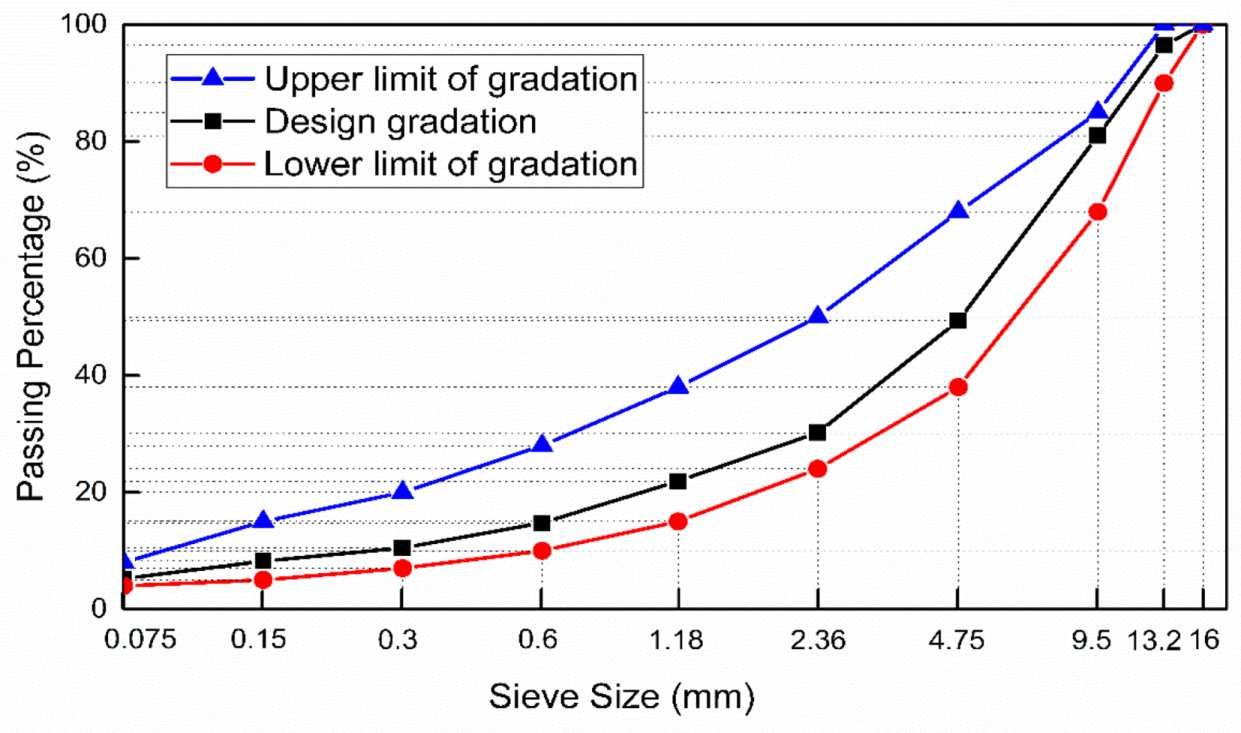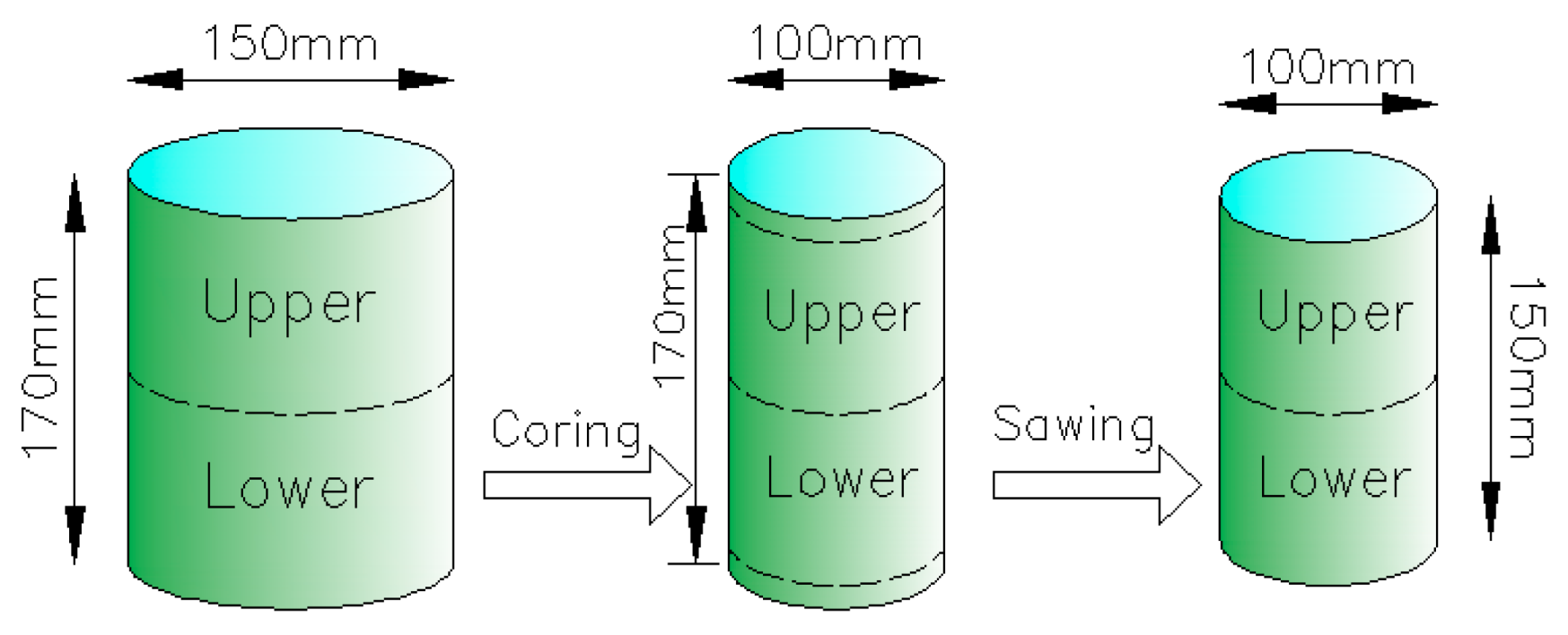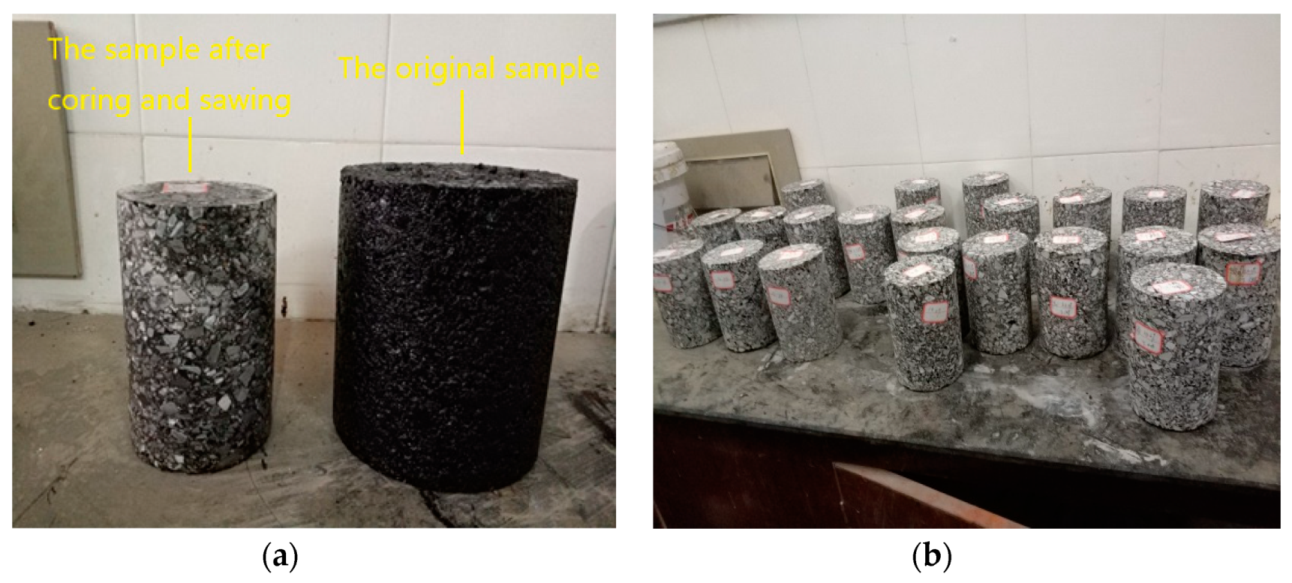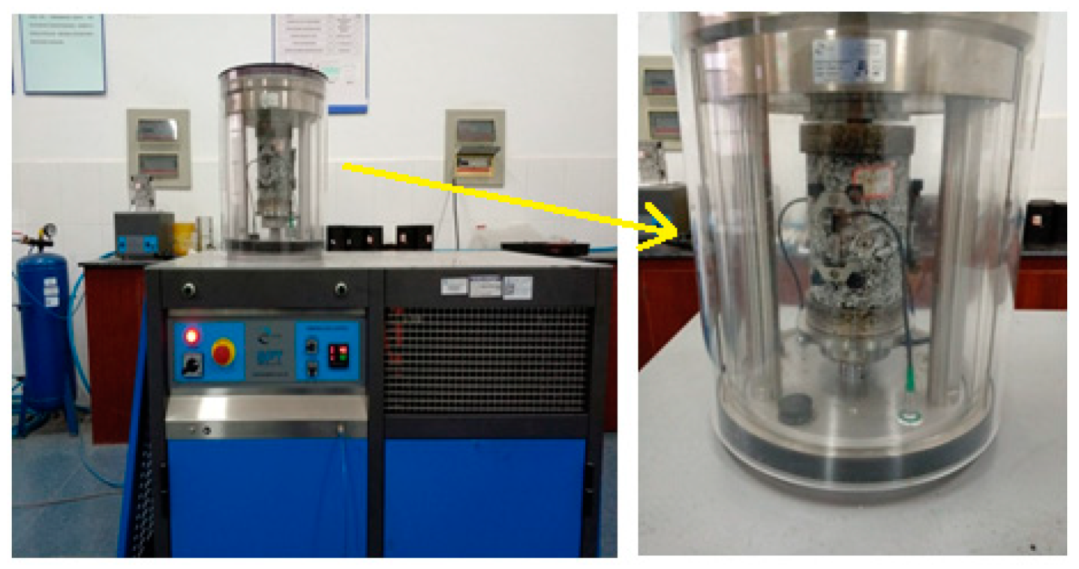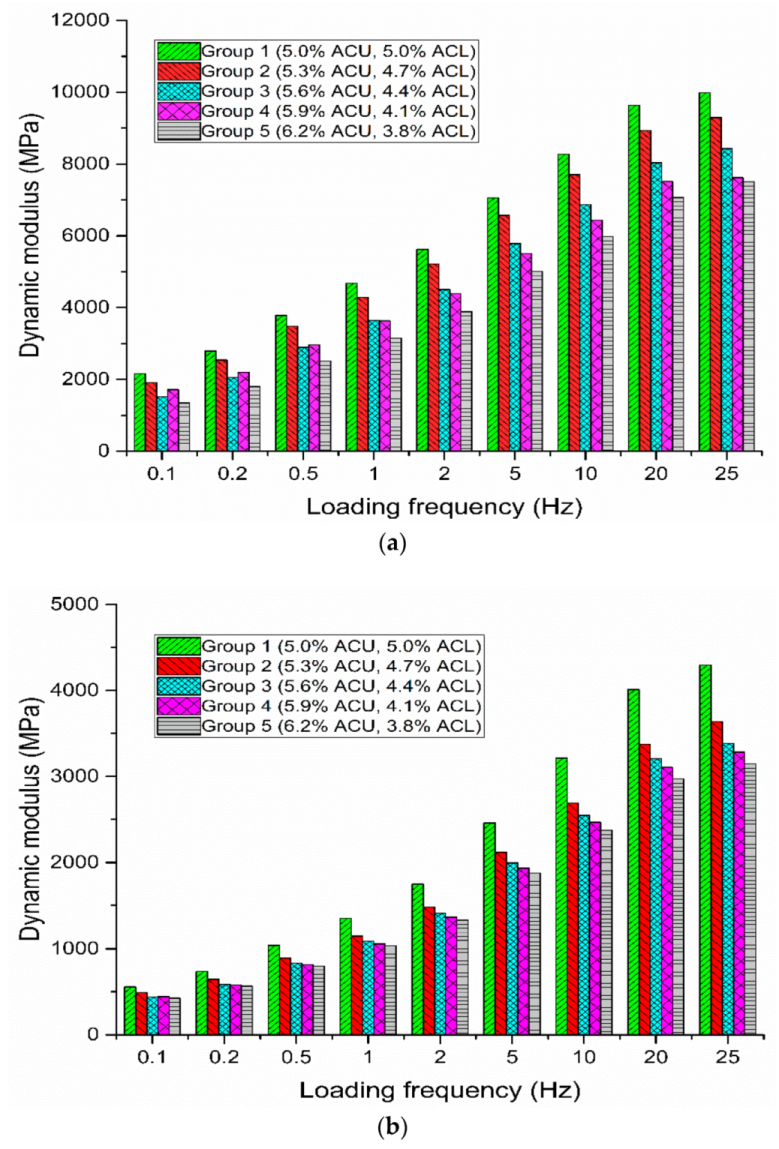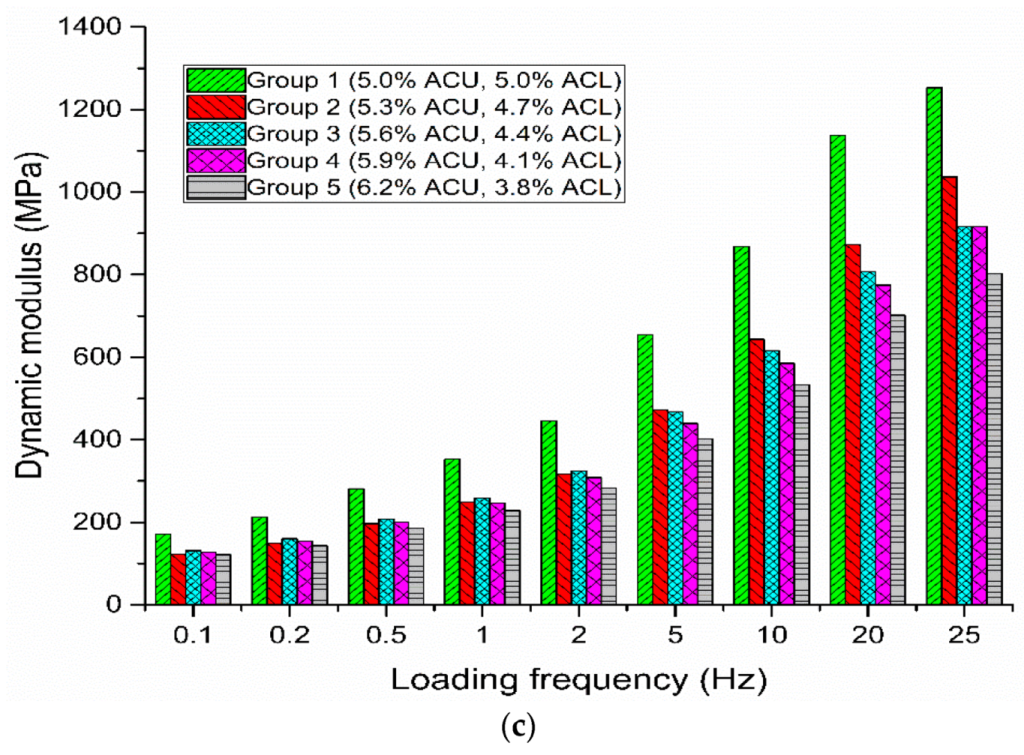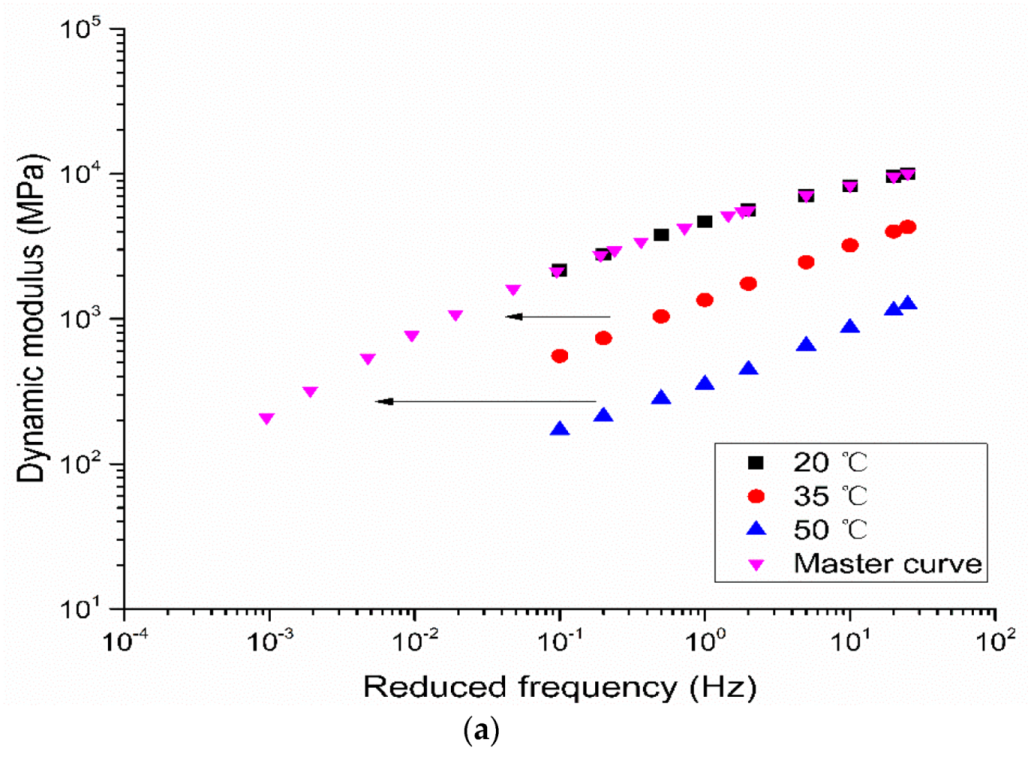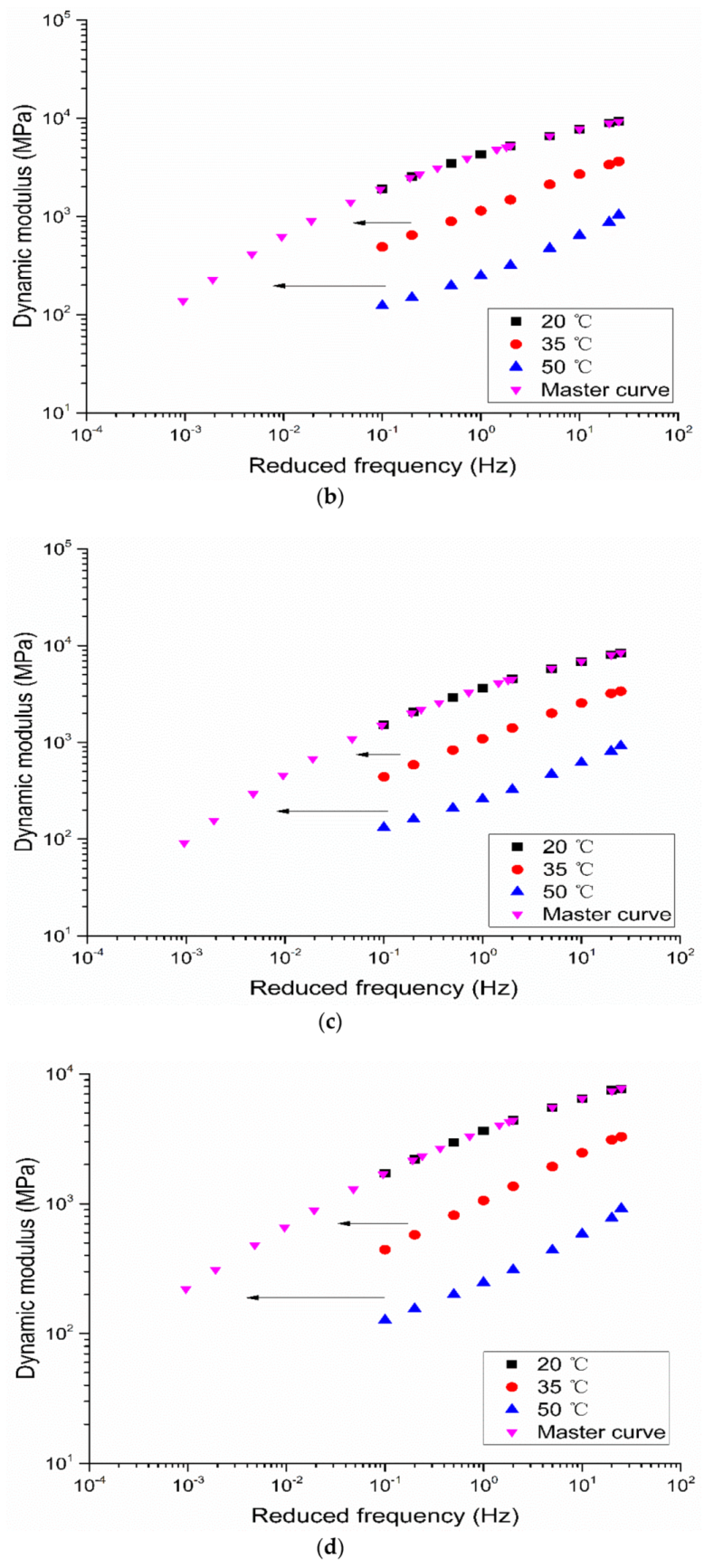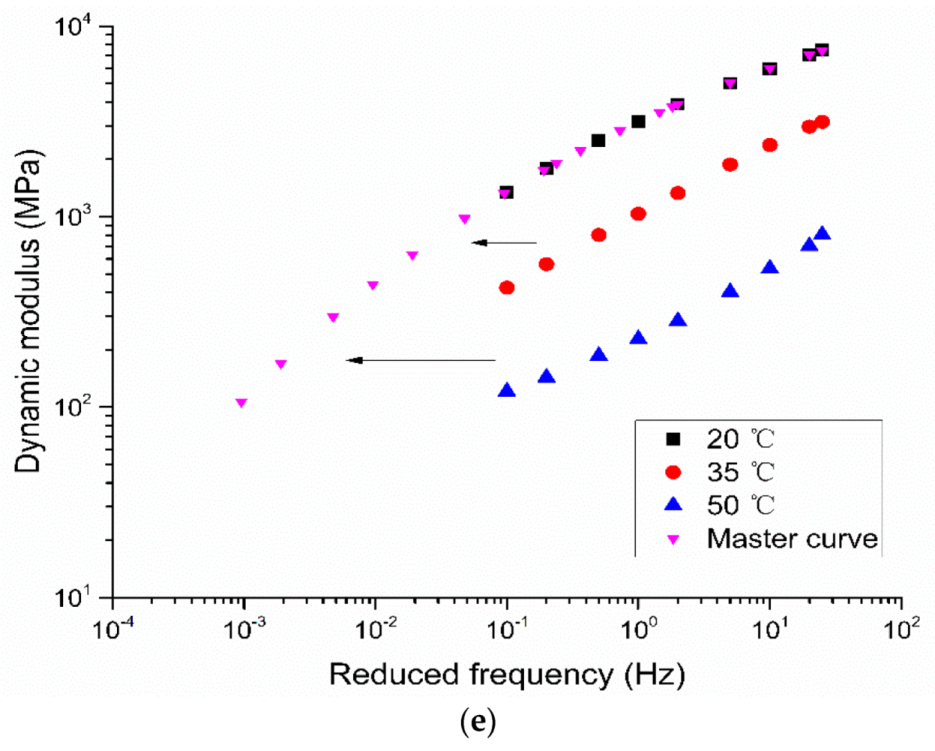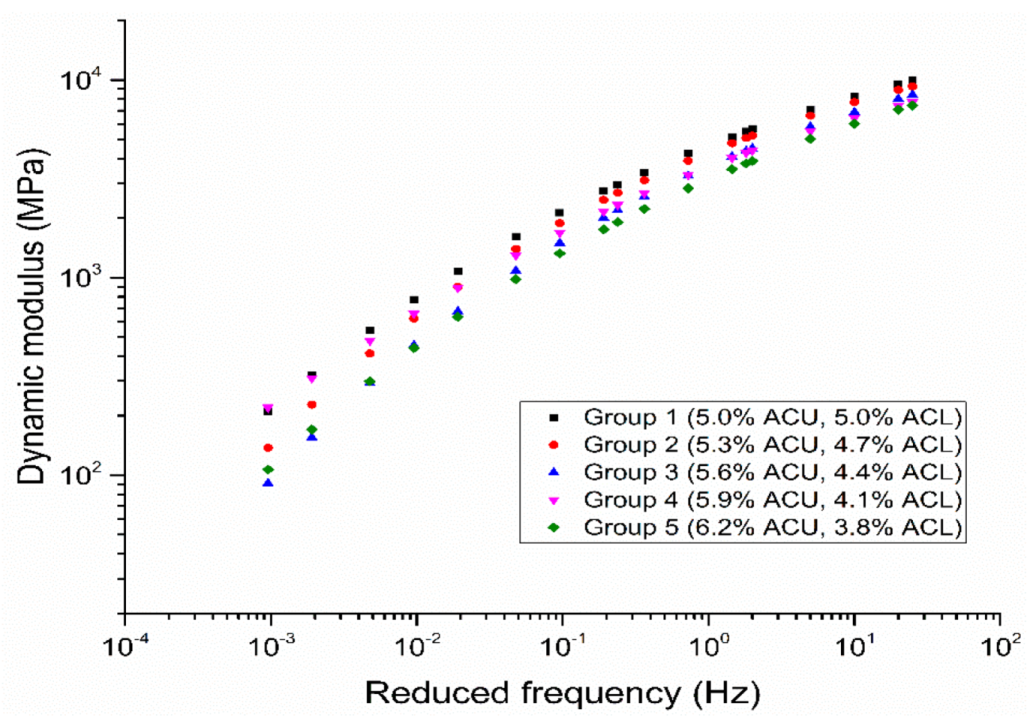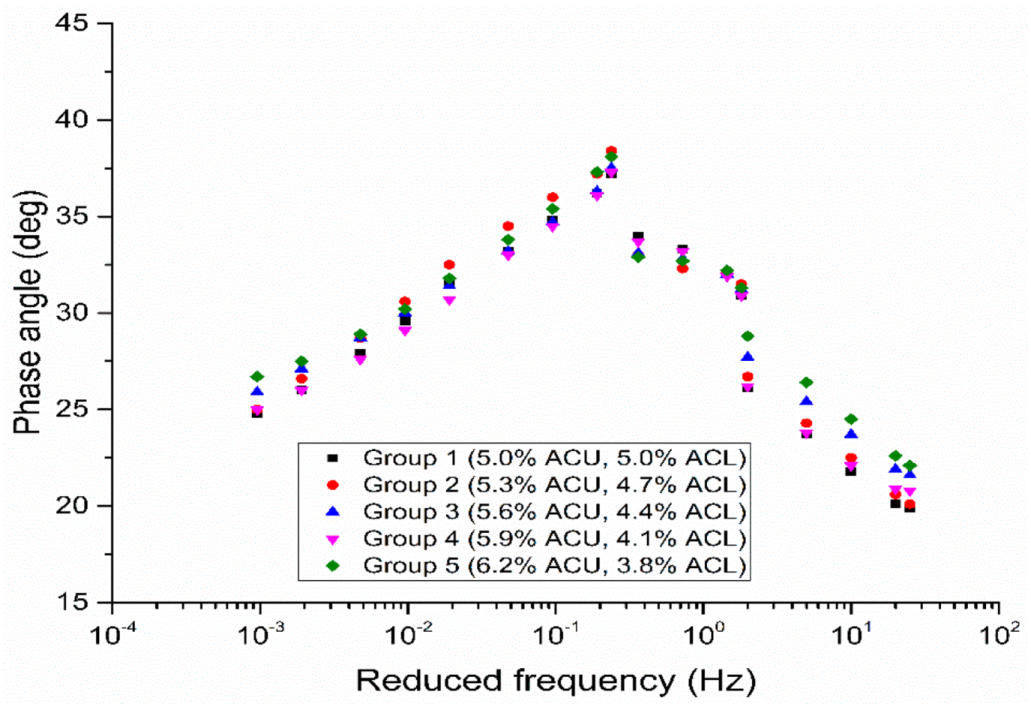3.1. Effects of Loading Frequency and Testing Temperature on the Dynamic Modulus
Asphalt mixture can be considered a linear viscoelastic material at low strain level. Its stress–strain relationship under a continuous sinusoidal (i.e., haversine) load is defined by a complex number called the “complex modulus”. The absolute value of the complex modulus is defined as the dynamic modulus [
30]. Research indicated that the dynamic modulus of asphalt mixture has a good correlation with its field rutting resistance [
31]. In this study, the dynamic modulus (|E*|) and the phase angle (δ) were determined by the following equations [
32]:
where |E*| is the dynamic modulus (MPa); σ is the peak dynamic stress (MPa); ε is the peak recoverable axial strain (με);
δ is the phase angle (°);
Ti is the time lag between a cycle of stress and strain (s);
Tp is the time for a stress cycle (s). Generally, the higher the dynamic modulus value is, the more resistant to rutting (permanent deformation) the asphalt mixture will be. The lower the phase angle value, the more elastic the asphalt mixture.
Table 4,
Table 5 and
Table 6 show the test results of the dynamic modulus and phase angle at different testing temperature, respectively, where G-S represents group of samples; M-P represents the mechanical parameters; S-P represents the statistic parameters;
is the average value of dynamic modulus;
is the average value of phase angle; σ is the standard deviation;
is the coefficient of variation (%).
For the construction of master curves, the shift factors should be obtained firstly. In this paper, the Williams–Landel–Ferry (WLF) equation was adopted to calculate the shift factors (Equation (3)):
where
is the shift factor;
and
are constants depending on the reference temperature;
Tr is the reference temperature in Kelvin;
is the test temperature in Kelvin.
The WLF equation is widely used in the calculation of shift factors and has a limitation of applicable temperature range of T
g < T < T
g + 100 °C (T
g: glass transition temperature), in which range, the equation applicable results satisfy the test data better [
33]. With shift factors, the curves at other temperature can be shifted to the reference temperature to form the master curve.
The Sigmoidal function is considered to fit the master curves of the dynamic modulus of asphalt mixtures well by shift factors [
34]. In this paper, the Sigmoidal function (shown in Equation (4)) is adopted to determine the predicted dynamic modulus values by nonlinear least square method fitting in Origin software (OriginPro 2016, OriginLab Corporation).
where
is the minimum value of |
E*|;
+
is the maximum value of |
E*|;
and
are parameters describing the shape of the Sigmoidal function;
is the reduced frequency at reference temperature (Hz);
is the loading frequency (Hz).
The shift factors at different reference temperature are shown in
Table 7. The fitting parameters values of Sigmoidal function by Origin nonlinear least square fitting are shown in
Table 8.
Figure 5 presents the correlation between the dynamic modulus (|E*|) and loading frequency of five groups of asphalt mixture samples at different testing temperatures.
Figure 6 shows the master curves of dynamic modulus test results.
Figure 7 shows the master curves of dynamic modulus of five groups of samples.
As expected, from
Figure 5 and
Figure 6, the dynamic modulus of asphalt mixtures increase monotonously with the increase of loading frequency while they decrease with the increase of testing temperature. This suggests that asphalt mixtures mainly behave elastic at low temperature but are viscous at high temperature. Besides this, as is shown in
Figure 5c, the difference of dynamic modulus of five groups of asphalt mixtures are not distinct at low frequencies (less than 1 Hz), while the distinctions become obvious at high frequencies (from 1 Hz to 25 Hz), indicating that at high temperature, the difference of dynamic modulus at low frequencies is smaller than at high frequencies. According to the TTSP, a short time or a high frequency is equivalent to a low temperature and vice versa. So this may explain the phenomenon that permanent deformation (rutting) commonly occurs at the road section of steep slopes, intersections, and bus stations, etc., where, vehicles are in a status of slow speed, frequent braking, and long contact time between tires and the road surface. In addition, it can be seen from
Figure 5 and
Figure 6 that at each frequency, the dynamic modulus of the first group of asphalt mixture samples (have the optimum asphalt content of 5.0% in upper half layer and lower half layer) are the highest and then become smaller with the incremental difference of asphalt content in the upper and lower half portions. This suggests that the asphalt migration has compromised the mixture’s mechanical structure and the more asphalt migrates, the weaker the mechanical properties of the asphalt mixture will be. The simulation method of the state of asphalt migration in this paper can help us better construe this issue at the quantitative level. Moreover, from
Figure 6 and
Figure 7, the shift factors and master curves have widened the testing range and can relatively precisely predict the trend of the dynamic modulus in a wider range. Specifically, in
Figure 7, the master curves of dynamic modulus of five groups of samples flatten out with the increasing frequency and the dynamic modulus of the first group are highest, which is in accordance with the result reported above.
3.2. Effects of Loading Frequency on the Phase Angle
When the asphalt mixture bears the dynamic load, a phenomenon occurs where the strain response lags behind the loading stress. The degree of this lag can be characterized by phase angle (δ) (i.e., δ represents the viscoelasticity of asphalt mixture). Similar to the dynamic modulus, the master curves of the phase angle can be also obtained by the shift factors.
Figure 8 presents the master curves of phase angle of five groups of samples.
As is shown in
Figure 8, different from the master curves of dynamic modulus, the master curves of phase angle firstly increase with the increase of loading frequency to the highest point and then decrease with the further increase of loading frequency. This is because at low temperature, the asphalt mixture behaves as elastic and is mainly subjected to asphalt binder, so when temperature increases (or frequency decreases), the asphalt binder becomes soft and behaves as viscous, then leading to the increment of phase angle. At high temperature, asphalt mixture mainly behaves as viscous and the influence of the asphalt binder on the mixture becomes weak while the interlocking force between aggregates on mixture becomes distinct. Thus, with the further increase of temperature (or decrease of frequency), the phenomenon where the aggregates skeleton mainly bears the loading stress becomes more obvious, then leading to the decline of the phase angle. Additionally, compared with the dynamic modulus, the phase angle usually exhibits an overall upward or downward trend at one single temperature and mutation point. Therefore, the master curves of phase angle are not as smooth as that of dynamic modulus. Moreover, it can be seen from
Figure 8 that the phase angle of the first group (5.0% ACU and 5.0% ACL) are the smallest, indicating that the asphalt migration has compromised the aggregates skeleton and aggravated strain response lag. With the simulation method of the state of asphalt migration in this paper, this phenomenon can be better understood at the quantitative level.
3.3. Analysis of |E*| and |E*|/sinδ
According to Witczak’s research, the dynamic modulus (|E*|) and the stiffness parameter (|E*|/sinδ) of asphalt mixture have a good correlation with the rutting resistance of asphalt pavement, and the stiffness parameter of asphalt mixture can more precisely reflect its rutting resistance at relative high service temperature [
35]. Generally, the higher the stiffness parameter value, the more resistant to rutting (permanent deformation) the asphalt mixture.
In this study, the dynamic modulus and the stiffness parameter were accessed at the intermediate loading frequency of 10 Hz and high testing temperature of 50 °C. The test results are shown in
Figure 9.
Figure 9 presents that the dynamic modulus and the stiffness parameter of five groups of asphalt mixtures decrease with the incremental difference of asphalt content in the upper and lower half layers and have the highest values at the optimum asphalt content (5.0% ACU and 5.0% ACL). This suggests that the asphalt migration has weakened the rutting resistance of asphalt mixture, and the more asphalt migrates, the less rutting resistance of the asphalt mixture. It is mainly due to the fact that, on one hand, when the asphalt migration has occurred at high temperature, the free asphalt in the upper half layer increases (as is simulated in this paper), having strengthened the lubrication between asphalt and aggregates (i.e., reduced the cohesion), and finally reduced the rutting resistance. Similarly, on the other hand, when asphalt migration has occurred at high temperature, the structural asphalt in the lower half layer decreases, having reduced the cohesion between asphalt and aggregates, so the rutting resistance of asphalt mixture declines. Therefore, it can be concluded that when asphalt migration occurs amid the asphalt pavement layers in hot climate regions, the rutting resistance of asphalt pavement becomes weaker and the rutting becomes worse.
